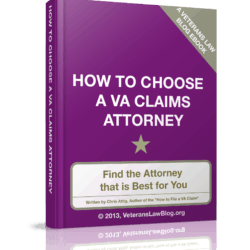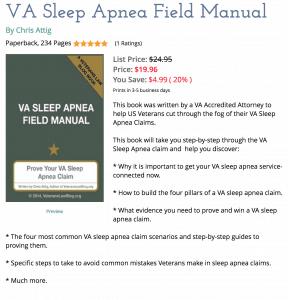Almost every veteran I know has filed a claim to service connect a VA disability for hearing loss. I’m sure that somewhere in some unit in the military, there is no noise. And because there is no noise, the veterans who served in this imaginary unit never experienced hearing loss.
That is not true for the large majority of veterans – each and every one of us was exposed to intolerable levels of noise in service. Military equipment is loud, because the work it does is loud. Each and every one of us who served in the military should probably receive VA disability for hearing loss. Even the Department of Veterans Affairs acknowledges that hearing loss and tinnitus are the most prevalent service-connected disabilities among veterans.
The health care research side of the VA even observes:
“As of the close of fiscal year 2014, more than 933,000 Veterans were receiving disability compensation for hearing loss, and nearly 1.3 million received compensation for tinnitus. In addition, many Veterans score normally on hearing tests but have difficulty understanding speech. This condition, called auditory processing disorder, is often associated with blast exposure.”
That said, the VA makes it damn near impossible to prove service connection for hearing loss and recover VA disability compensation for that hearing impairment, and to secure a higher rating when your hearing impairment is more profound than what certain tests can measure.
3 Things to prove in a VA Disability for Hearing Loss claim or appeal.
There are 3 things you must prove to establish service connection in any VA disability claim, but as you will see, the VA makes it particularly hard to prove a hearing loss disability is related to military service.
The first hurdle you have to cross is proving that your hearing loss is a disability.
The second hurdle you have to clear is demonstrating that it your hearing loss is related to your military service.
And the third hurdle you have to cross is establishing a VA hearing loss rating. That is, you have to show that your hearing loss is substantial enough to warrant an impairment rating. A lot can be said about the way the VA rates hearing loss, but that is not what this post is about.
This post is about the first hurdle – proving that your hearing loss is a VA disability.
How to establish you have a VA hearing loss disability claim.
The general definition of what constitutes a disability for service connection purposes appears in 38 U.S.C. §1110 as interpreted by the Federal Circuit in Saunders. That is, if a medical condition or symptoms, regardless of their etiology or diagnostic title, cause a functional loss in earning capacity, it is a disability for VA disability compensation purposes. Hearing loss is unique among VA disabilities because it is one of the few for which the VA provides a specific definition in the Code of Federal Regulations.
38 C.F.R. §3.385 defines the three ways to prove that you have a VA hearing loss disability:
- Auditory threshold in any of the frequencies 500, 1000, 2000, 3000, 4000 Hertz is 40 decibels or greater; or
- Auditory thresholds for at least three of the frequencies 500, 1000, 2000, 3000, or 4000 Hertz are 26 decibels or greater; or
- Speech recognition scores using the Maryland CNC Test are less than 94 percent.
Below we will look at each in turn.
Method #1: Auditory thresholds at 40 decibels or greater.
For impaired hearing will be considered to be a disability by the VA, the auditory threshold in any of the frequencies 500, 1000, 2000, 3000, 4000 Hertz must be 40 decibels or greater. The higher numbers are high frequencies and the lower numbers are low frequencies.
Auditory thresholds, in their simplest definition, measure your ability to hear.
They are the minimum sound level, in decibels, of a tone at a particular frequency, that your ear can hear with no other sound present. So your hearing impairment is a disability for the purposes of your VA claim if the quietest sound you can hear at the above 5 frequencies is 40 decibels or greater.
Where does the auditory threshold come from?
To measure auditory thresholds, the VA requires a test known as the Puretone Audiometric Test.
The Puretone test measures only your auditory thresholds. It does not measure other aspects of hearing loss such as sound localization and speech recognition, and so if your VA hearing loss disability involves these symptoms, you might be able to establish entitlement to a higher disability rating using the concept of extra-schedular rating in your VA hearing loss claim.
The Puretone Audiometric Test must be administered by a licensed audiologist, and you should not be wearing hearing aids during the test.
For that reason, in determining whether or not the VA correctly decided whether or not you have a hearing loss disability, it is critical to know the credentials of the audiologist who performed the Puretone Test.
The VHA does not know how many doctors it employs, and it certainly has no idea which ones of them may or may not be currently licensed.
There’s a fairly decent chance your audiologist has not been licensed to practice medicine, so look into it.
Method #2: Auditory thresholds greater than 26 decibels.
If your auditory thresholds are greater than 26 decibels in at least of the following frequencies, then your impaired hearing will be considered a disability for hearing loss purposes: 500, 1000, 2000, 3000, or 4000 Hertz.
Pretty straightforward proof.
Again, keep in mind that you should not be using hearing aids during these tests.
Method #3: Speech Recognition less than 94 percent.
Explained simply, speech recognition measures how well you can understand spoken words when they are loud enough to hear comfortably.
To measure speech recognition, the VA uses the Maryland CNC test. CNC stands for consonant-vowel nucleus consonant. It is basically a list of certain words with particular structures that can be used to measure the listeners ability to distinguish sounds.
All speech recognition tests rely on word lists. The word list options in a given test allow the results of that test to be normalized and measured. However, because language changes over time, and because spoken English and written English can be very different, the older the word lists, the less valid they are. I could not find an exact date that the Maryland CNC test word lists were created, but I did find references to them as early as 1962.
If your speech recognition scores are less than 94 percent – without the benefit of your hearing aids – meaning you could not distinguish between 94 percent of the tested words on the test – then you have established hearing loss for VA disability purposes.
So there you have it.
Three ways to prove you have a hearing loss disability for the purposes of your VA claim. Unless you can establish that your current hearing loss is a disability by using one of these three tests, then you will not be able to receive service connected disability compensation for your military hearing loss.





